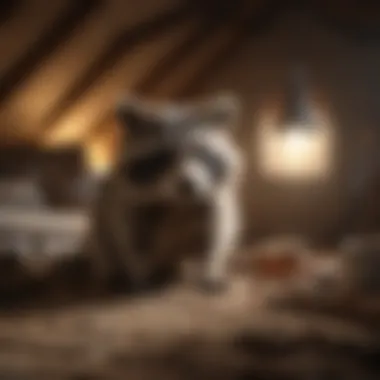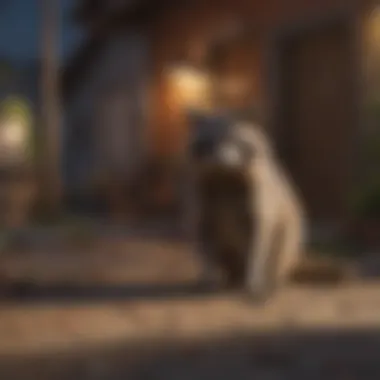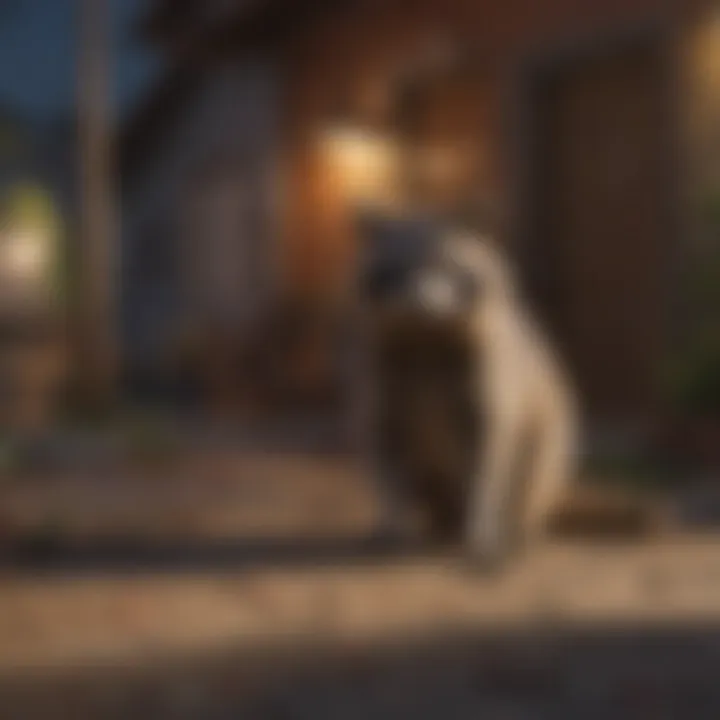Can Raccoons Thrive in Hot Attics?


Intro
Raccoons are often viewed as nuisance pests, especially when they decide to invade attics. Their adaptability to various environments raises the question of their ability to thrive in hot attics. This article delves into the biology, behavior, and impact of raccoons as they make themselves at home in residential spaces, particularly in heat-prone areas. Understanding how these creatures manage increased temperature is crucial for homeowners seeking to prevent infestations and implement effective pest control measures.
Understanding the Pest
Identification
Raccoons can be identified by their distinctive black facial markings and bushy tails. They are medium-sized mammals, typically weighing between 8 to 20 pounds. Their front paws are notably dexterous, allowing them to manipulate objects with surprising skill. This adaptability is significant when they enter human dwellings, often seeking food and shelter in attics.
Life Cycle
The reproductive cycle of raccoons contributes to their increasing presence in urban areas. Female raccoons give birth to usually three to five kits in the spring. These kits remain dependent on their mother for several months, during which time they learn essential survival skills. The lifespan of a raccoon can reach up to three years in the wild, but they can live longer in captivity. Their ability to reproduce quickly exacerbates the pest problem for homeowners.
Pest Prevention Strategies
Environment Modification
To deter raccoons from entering an attic, it's vital to modify the environment around the home. Key strategies include:
- Removing food sources: Secure trash bins with tight-fitting lids. Avoid leaving pet food outdoors and clean up any fallen fruit from nearby trees.
- Landscaping adjustments: Trim branches that provide access to roofs, safeguarding potential entry points.
Physical Barriers
Installing physical barriers is an effective way to prevent raccoon access. Options include:
- Screens: Use sturdy screens on vents and gaps in the roof to block entry.
- Strong covers: Attach covers on chimneys and other open areas. Ensure there are no holes larger than four inches, as raccoons can squeeze through surprisingly small openings.
Control Methods
Chemical Control
Chemical control is less commonly recommended due to potential risks to pets and humans. However, there are repellents available that can deter raccoons. These usually contain natural ingredients that are unpleasant to these animals. It's crucial to follow application instructions and safety guidelines.
Biological Control
Biological control methods may involve the introduction of natural predators but are generally not practical in residential areas. Focusing on preventive measures is typically more effective in managing raccoon populations.
Key Takeaway: Raccoons are remarkably adaptable creatures. Their ability to thrive in various environments, including hot attics, presents significant challenges for homeowners. Understanding behavior and implementing targeted strategies is crucial for effective pest management.
Prelims to Raccoon Habitation
Understanding the topic of raccoon habitation is crucial for homeowners who may encounter these creatures in their properties. Raccoons have shown an impressive ability to adapt to various environments, including urban settings. This adaptability allows them to thrive in spaces typically meant for human use, such as attics. By examining the factors surrounding their presence in residential areas, homeowners can better understand the implications of raccoon habitation.
Raccoons can potentially lead to a variety of issues once they establish residence in attics. Their habits can create health hazards and cause structural damage. Recognizing these risks early allows for more effective management strategies. In this section, we will delve into the adaptability and habits of raccoons, setting the stage for understanding their impact on home environments.
Overview of Raccoon Adaptability
Raccoons are known for their intelligence and problem-solving skills. These traits significantly contribute to their ability to adapt to different habitats. They can exploit food sources and find shelter in a range of environments. Their flexible diet includes fruits, nuts, insects, and human food scraps. This variety makes them less reliant on a specific type of habitat, allowing them to thrive even in urban areas.
In addition, raccoons can withstand various weather conditions. They have thick fur that provides insulation against cold, and they can regulate their body temperature to cope with heat. This physiological adaptability means they can potentially live in hot attics without immediate adverse effects.


Common Habitats of Raccoons
Raccoons are highly adaptable creatures that inhabit diverse environments. Common settings include:
- Forests and Woodlands: Some raccoons prefer natural habitats, where they can find ample food and shelter.
- Urban Areas: Many raccoons have adapted to city life, utilizing garbage bins and backyards as food sources.
- Agricultural Areas: Fields can provide food, but these locations might also lead raccoons closer to human dwellings.
In urban settings, attics, basements, and garages often become attractive options for raccoons seeking warmth and safety. Their ability to climb and squeeze through small spaces makes attics particularly susceptible to invasion.
Overall, recognizing raccoon's adaptable nature helps homeowners understand potential encounters. This knowledge leads to proactive measures in preventing unwanted habitation.
Physiological Adaptations to Heat
Understanding the physiological adaptations of raccoons to heat is crucial in assessing their survival in hostile environments like hot attics. These adaptations can dictate both how raccoons manage to thrive in extreme temperatures and the subsequent implications this has on human living spaces. Recognizing these factors is essential for homeowners facing potential infestations.
Raccoons have evolved various mechanisms to tolerate elevated temperatures. Understanding these mechanisms allows us to appreciate their resilience and potential risks they pose when they invade human habitats.
Thermoregulation Mechanisms
One key aspect of raccoon physiology is their effective thermoregulation. Raccoons possess a fur coat that provides insulation from both hot and cold temperatures. While this fur is generally associated with warmth, during hotter months, it can assist in regulating body temperature. Raccoons can also sweat, however, it's very minimal. Instead, they utilize behaviors such as sunbathing during cooler parts of the day and seeking shade to avoid overheating. These proactive behaviors are critical as they help maintain their body heat within a survivable range.
It’s noteworthy that raccoons have a flexible metabolic rate that adjusts to temperature extremes. When it's hot, their metabolism can slow down, lowering their energy requirements and reducing the overall heat generated within their bodies. This adaptability is vital, especially when they live in confined spaces with limited airflow, like attics.
Hydration Needs in Hot Conditions
Hydration is another pivotal component of raccoon survival in hot conditions. Raccoons are primarily nocturnal, which helps reduce their exposure to daytime heat. At night, they are more active, searching for food and water. Staying hydrated is essential for them to regulate body temperature and sustain their activity levels.
In a hot attic, water sources may be limited, but raccoons often compensate by obtaining moisture from the food they eat. Fruits, insects, and small mammals can provide needed hydration. However, an attic environment may not always offer these food sources, leading to potential challenges in water acquisition.
"Raccoons can adapt effectively to hot attics, but their hydration levels must be monitored. Inadequate hydration can affect their health, ultimately leading to more aggressive behavior in search of water."
Behavioral Responses to High Temperatures
Understanding the behavioral responses of raccoons in high temperatures is essential for comprehending their adaptability and survival in varied conditions. Raccoons, like many mammals, exhibit alterations in their behavior when faced with extreme heat. These adjustments are vital not only for their own survival but also for homeowners who might face challenges when dealing with raccoon infestations in attics, especially during warm summer months. Recognizing these behaviors can help assess the potential problems that may arise when raccoons seek shelter in residential areas.
Activity Patterns in Hot Weather
Raccoons experience noticeable changes in their activity patterns when exposed to high temperatures. Typically, they are nocturnal animals. This primarily means they are most active during the night and tend to avoid peak heat during the day. As the temperature rises, raccoons may have even more pronounced nocturnal behaviors. For instance, they might increase their foraging activities in the cooler evening hours to minimize heat exposure.
Moreover, these animals tend to select feeding grounds that provide shade or water sources. During very hot periods, they may decrease the duration of foraging sessions, opting instead for shorter, more frequent trips in search of food. Their preference for damp environments can lead them to areas near water, as hydration plays a key role in their survival during heat.
"Raccoons show flexibility in their timing and location of activity, which reflects their considerable adaptability to environmental changes."
Sheltering Behavior
During periods of extreme heat, raccoons also modify their sheltering behavior significantly. Finding suitable places to hide from the sun becomes a priority. Hot attics can pose significant challenges due to their temperatures, yet raccoons may still choose these spaces if other options are limited. They often seek out hidden areas within walls, roofs, or ducts that offer some form of escape from direct sunlight and high environmental temperatures.
In addition, raccoons are known to share these spaces with other raccoons. The social structure and mutual grooming they engage in can help in managing body heat during the hotter months. If any attic space has been compromised, it may lead to an increase in communal living among raccoons, escalating health risks for humans and more potential damage to property.
Identifying areas of potential entry and understanding these behavioral responses is crucial for homeowners. By knowing when and where raccoons are likely to invade, preventative measures can be effectively employed to reduce the risks these creatures present during the summer months.
Risks Associated with Raccoon Infestations
Understanding the risks associated with raccoon infestations is essential. When these animals take up residence in areas like attics, they can create multiple problems that affect both property and health. Their presence may be more than an inconvenience, leading to significant consequences for homeowners. As we examine the potential health concerns and property damage, it becomes clear that prompt action and consideration are necessary.


Health Risks to Humans
Raccoons can pose various health risks to humans. A primary concern is the transmission of diseases. Raccoons are known carriers of Rabies, a viral infection that affects the central nervous system and can be fatal without treatment. While the percentage of raccoons carrying rabies is relatively low, the risk remains real, especially in close proximity to human dwellings.
Moreover, raccoons can harbor parasites such as roundworms, which can cause severe illness in humans. The eggs of the raccoon roundworm can be transmitted through contact with contaminated soil or surfaces, leading to infections that may require medical intervention.
Additionally, raccoon droppings can harbor Giardia, a parasite that can cause gastrointestinal distress in humans. These parasites can thrive and multiply in unclean environments. Homeowners must be vigilant about hygiene and sanitation in areas where raccoons might frequent.
Property Damage Concerns
The damage caused by raccoons in residential areas is significant. First, they can compromise the structural integrity of a home. Raccoons are adept at accessing attics and can tear through insulation and wooden beams, causing lasting damage. The entry points they create can allow further pests or elements, like moisture, to enter.
Second, they often create nests using materials found in the attic, such as insulation or personal belongings. This behavior can lead to a costly cleanup process. The need to repair any structural damage, replace insulation, or clean up the mess they leave behind can quickly add up.
Finally, raccoon infestations can lead to costly complications involving pest control services. Hiring professionals to remove them and ensure proper exclusion techniques can become an unexpected financial burden for homeowners.
"Ignoring raccoon infestations can escalate damage and health risks, making proactive steps essential."
In summary, the health risks and property damage associated with raccoon infestations warrant serious consideration. Homeowners should be acutely aware of these issues, as they can have long-lasting repercussions. Not only are immediate costs involved in dealing with the raccoons, but there could also be ongoing health and safety concerns to monitor. By being informed, residents can take appropriate preventative measures.
Preventive Measures for Raccoon Entry
Understanding Preventive Measures for Raccoon Entry is critical for homeowners who want to protect their properties from these adaptable creatures. Raccoons are known for their intelligence and problem-solving abilities, making them adept at finding ways into attics and other hidden spaces. By implementing the right strategies, homeowners can significantly reduce the risk of these unwanted guests.
Identifying Entry Points
The first step to preventing raccoon entry is to identify potential entry points around the home. Common entry points include:
- Gaps in roofs or eaves: Look for loose shingles or holes where raccoons can get in.
- Vents: Dryer vents, attic vents, and other openings can be easily accessed.
- Broken windows: Any cracked or broken window can be an open invitation.
- Chimneys: A damaged or unprotected chimney can allow easy entry.
During this process, it is important for homeowners to take a comprehensive look around their property. Using a flashlight can help illuminate darker areas and make it easy to spot potential hiding places. Regular inspections, especially after severe weather, are essential in maintaining home security.
Effective Sealing Techniques
Once entry points are identified, addressing these vulnerabilities is crucial. Effective sealing techniques include:
- Repairing holes: Cover any structural gaps with materials such as metal flashing or hardware cloth.
- Securing vents: Install raccoon-proof vents to prevent access while allowing for ventilation. This keeps areas well-ventilated without compromising security.
- Installing chimney caps: A good chimney cap prevents entry without obstructing airflow.
- Using locks and latches: For openings like windows, consider adding sturdy locks.
Preventive maintenance is key to securing your home against raccoons. Regularly check and maintain these protective measures to ensure they are effective. Raccoons are persistent; even a small hole can lead to major infestations.
"Prevention is always better than cure, especially when it relates to wildlife management in your home."
Humane Control Methods
Humane control methods are essential in managing raccoon populations, especially in residential areas. Understanding these methods can offer solutions that respect animal welfare while effectively addressing the issue of raccoons taking shelter in attics. Human intervention often stems from the desire to maintain a healthy living environment, protecting both the property and its inhabitants from potential risks associated with raccoon infestations.
Trapping and Relocation
Trapping and relocation is a common strategy for managing raccoon populations. This humane method involves using traps designed to safely capture raccoons without causing them harm. It is vital to follow local laws during this process, as many regions have regulations on the capture and relocation of wildlife. The primary steps in this method include:
- Selecting Appropriate Traps: Choose traps that are large enough to accommodate a raccoon but sturdy enough to prevent escape. Live traps are typically recommended.
- Baiting the Traps: Use food that raccoons find appealing, such as fruits or cat food. Proper bait placement is crucial for successful trapping.
- Monitoring the Traps: Check traps often, at least once every few hours, to ensure any captured raccoons are attended to promptly.
- Relocation: Once captured, raccoons should be transported to an area where they can thrive without causing issues for homeowners, typically at least several miles away from the site of capture.
It is important to note that trapping should only be a temporary solution. Following this method, residents should look for opportunities to prevent future infestations.


Exclusion and Deterrence Strategies
Exclusion and deterrence strategies focus on preventing raccoons from returning after they have been removed. These methods contribute significantly to long-term solutions that integrate with humane practices. Some of the most effective strategies include:
- Inspecting for Entry Points: Regularly check your property for gaps where raccoons might enter, such as holes in roofs, vents, or by trees and fences. Sealing these entry points is essential.
- Securing Trash Containers: Raccoons are often attracted to easy food sources. Make sure trash bins are securely closed and use raccoon-proof lids.
- Removing Attractants: Any food that can attract raccoons should be removed, including pet food left outside and compost piles that might not be secure.
- Using Repellents: Certain smells, like citrus or vinegar, can deter raccoons. Applying these in areas where they are likely to enter may help keep them away.
The key to preventing future issues lies in understanding and addressing the root causes of attraction.
Implications for Homeowners
Understanding the implications of raccoons living in heated spaces such as attics is crucial for homeowners. This knowledge can help in proactive management of potential infestations and reduce future complications. Homeowners must recognize not only the presence of raccoons but also the broader impact this can have on property and daily life.
One significant element is property value. A raccoon infestation can lead to considerable damage. Raccoons are notorious for tearing up insulation, degrading wiring, and even compromising structural components, all of which can result in costly repairs. Furthermore, properties known to have pest issues can deter potential buyers, causing long-term financial effects. Maintaining a raccoon-free home helps preserve property aesthetics and value.
Another vital aspect homeowners should consider concerns insurance implications. In many instances, insurance policies may not cover damages resulting from animal infestations. Homeowners need to read their policies carefully to understand any exclusions that may apply. If an insurance company decides that neglecting preventive measures leads to damages, claims might be denied. This may lead to hefty out-of-pocket expenses for repairs.
Overall, the implications of allowing raccoons to inhabit areas of the home encompass a range of facets that all homeowners ought to ponder. By staying informed, homeowners can take necessary steps to prevent these furry invaders from settling in, safeguarding both their property and financial investments.
"A proactive approach is always more advantageous than dealing with the aftermath of an infestation."
Impact on Property Value
The presence of raccoons in attics can have an adverse effect on property value. Raccoons can create significant damage. They often tear through insulation materials and can chew on wiring. This not only affects the aesthetics and functionality of the home but could also pose safety hazards.
Damage from an infestation can manifest through several areas, including:
- Insulation degradation
- Structural damage from nesting activities
- Contamination of attic spaces with droppings or urine
Prospective buyers may view these issues as red flags, leading them to either negotiate a lower price or move on entirely. It is vital for homeowners to document and address any signs of infestation immediately to avoid long-term devaluation of their properties.
Insurance Considerations
Raccoon infestations bring critical insurance considerations that homeowners should not overlook. Many insurance policies have specific clauses regarding wildlife damage. Often, raccoon-related damage might be categorized as preventable, meaning claims could be denied if proper precautions were not taken.
Homeowners must consider the following when it comes to insurance and raccoon issues:
- Policy review: Understand the specifics of what is covered and what is not related to animal damage.
- Preventive measures: Taking steps to maintain a raccoon-free environment can be essential for ensuring coverage in the event of damage.
- Consultation with the agent: Speaking with an insurance representative can provide clarity on how specific situations are handled under the policy.
Being informed about these factors enables homeowners to make wise decisions about property management and maintenance, ultimately protecting their investments.
End and Recommendations
Raccoons' ability to inhabit varied environments, including hot attics, raises important issues. Understanding the implications of their presence is vital for homeowners. The findings about raccoon adaptability underscore the need for effective pest management. Homeowners must recognize the risks and take measures to mitigate them to maintain safety and property integrity.
Recap of Key Findings
Raccoons are remarkably adaptable creatures. They can survive in extreme heat by utilizing physiological and behavioral mechanisms. Here are the key takeaways:
- Physiological Adaptations: Raccoons regulate their body temperature and need to hydrate more in hot environments.
- Behavioral Patterns: Their activity levels change with temperature, often becoming nocturnal during warmer periods. They seek shelter like attics to avoid the heat of the day.
- Risks for Homeowners: Infestations may lead to health hazards, such as diseases carried by raccoons. Property damage is also a concern, as they can cause severe structural issues when trying to enter homes.
These insights reveal the dual challenges of raccoon habitation. Homeowners must stay vigilant and informed.
Final Recommendations for Homeowners
To effectively manage raccoon presence, certain actionable steps should be taken:
- Inspect Your Property Regularly: Check for potential entry points, including gaps, loose vents, or openings in the roof.
- Secure Trash and Food Sources: Make sure outdoor trash bins close tightly. Raccoons are opportunistic feeders and will be drawn to easy food access.
- Learn About Local Wildlife Policies: Understanding laws about pest control can guide homeowners on humane practices.
- Consider Professional Exclusion: If raccoons are already present, seeking help from wildlife control professionals may be the safest and most effective course of action.
- Educate Others: Share knowledge about raccoon behavior and safety precautions within the community, fostering a collective approach to manage wildlife interactions.
By following these recommendations, homeowners can protect their properties while respecting wildlife. Awareness and proactive measures play a significant role in maintaining a safe and peaceful home environment.







